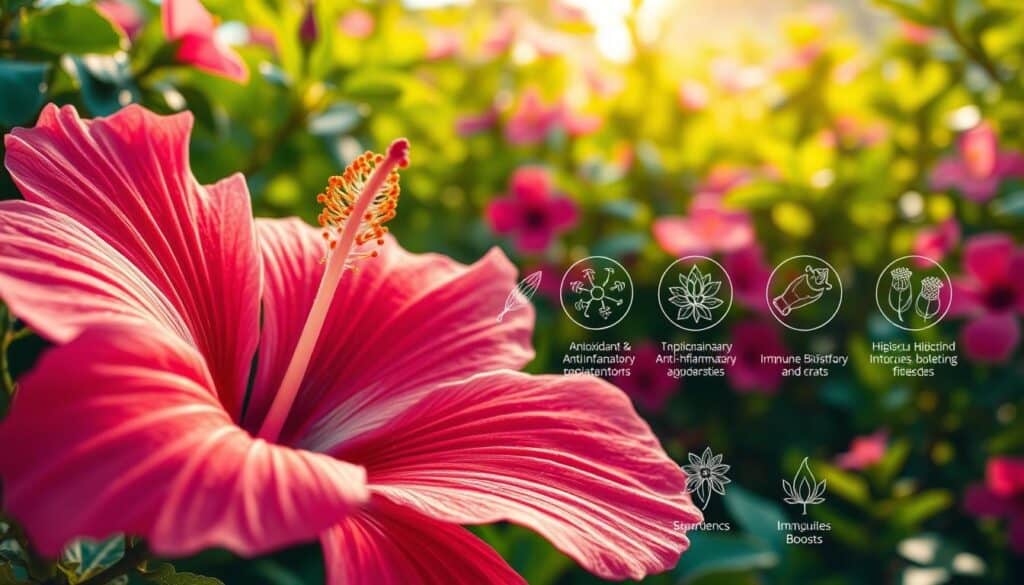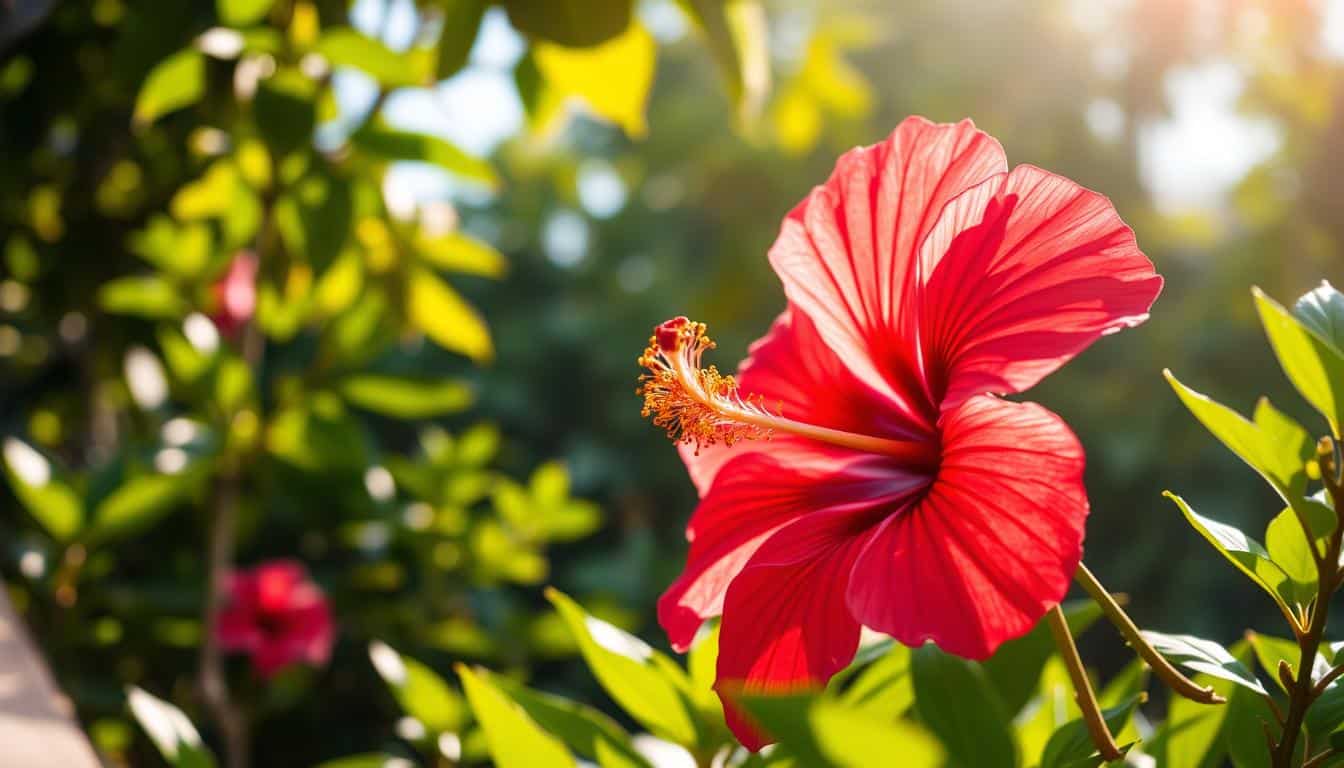The hibiscus flower, with its stunning blooms and distinct presence, stands as a testament to the wonders of flowering plants. A beacon of warmth and color, it beckons to be the next garden addition for both novice and experienced cultivators alike. Beyond its brilliant visuals, the hibiscus’s ease of care and adaptability meld seamlessly into various outdoor aesthetics, promising not just a mere addition, but a significant landscape enhancement.
Whether you aspire to line your pathways with splashes of color or yearn to create a tropical haven in your backyard, the hibiscus plant is ready to exceed your expectations. This introductory glimpse into the world of hibiscus will spotlight the compelling reasons these blossoms should grace every garden, joining the ranks of your cherished botanical companions.
Key Takeaways
- The hibiscus is a symbol of tropical beauty in a garden setting.
- As a versatile garden addition, hibiscus suits various landscape styles.
- These flowering plants offer easy care for garden enthusiasts.
- An ideal choice for landscape enhancement with their vivid blooms.
- Hibiscus plants can be centerpiece attractions or complementary accents.
The Vibrant Colors and Varieties of the Hibiscus Flower
The Hibiscus flower, renowned for its stunning floral display and diverse color palette, offers a vibrant burst of color with every bloom. Whether you are captivated by the perennial beauty of these exotic blooms or looking to introduce a spectacular range of hues to your garden, Hibiscus plants are an excellent choice. These flowers not only enliven a garden with their dramatic presence but also create a changing landscape of colors with their periodic blooms.
The Rainbow Spectrum of Hibiscus Colors
Hibiscus flowers dazzle with a spectrum that includes every color imaginable, from deep blues to fiery reds and sunny yellows. This colorful array can be strategically used to craft a garden that reflects your personal aesthetic and design vision, making it a true paradise of hues.
Different Varieties for Every Garden Style
Regardless of your garden’s style, there’s a Hibiscus variety that fits perfectly. From the large, bold blooms of the Hibiscus rosa-sinensis, ideal for a tropical setting, to the more delicate flowers of the Hibiscus syriacus, suited for cooler climates, the choices are limitless. Each variety not only brings its unique shade but also adapts differently to environmental factors, offering a diverse range of options for gardeners to explore.
Seasonal Blooms for Year-Round Color
One of the most enchanting features of the Hibiscus is its ability to bloom in different seasons, providing a colorful display throughout the year. With proper planning, you can achieve a continuous wave of blooms from spring to fall, ensuring your garden never loses its splendor.
| Variety Name | Color | Season |
|---|---|---|
| Hibiscus rosa-sinensis | Red, Pink | Year-round in tropics |
| Hibiscus syriacus | Blue, Lavender, White | Summer to fall |
| Hibiscus coccineus | Bright Red | Summer |
| Hibiscus trionum | Yellow with Dark Center | Summer |
With such a diverse color palette and range of blooming seasons, gardeners can enjoy the stunning floral display and perennial beauty of the Hibiscus flower in an endless ballet of hues and varieties that never ceases to captivate and enchant.
Easy Care and Low Maintenance Requirements
The allure of the hibiscus flower in home gardens can be attributed significantly to its simplicity in care and maintenance. Known for its lush, vibrant blooms, hibiscus cultivation often suggests a high-effort venture. On the contrary, these plants are perfect examples of low upkeep plants, making them ideal for both amateur and experienced gardeners. Below, we explore the essential care specifics that contribute to the gardening ease of these tropical beauties.
Watering and Light Needs
Hibiscus plants require consistent moisture to thrive, but they also need well-drained soil to prevent root rot. Regular watering is crucial, especially during dry spells. As for light, hibiscus flowers flourish in full sun, needing at least six hours of direct sunlight daily to produce their best blooms.
Soil Types and Fertilization Techniques
The right soil and fertilization are pivotal for successful hibiscus cultivation. A well-draining yet nutrient-rich soil underpins robust growth. Organic compost or a well-balanced fertilizer can enhance soil fertility and help sustain the vibrant blooms that hibiscuses are known for.
| Aspect | Ideal Condition for Hibiscus | Tips for Optimal Care |
|---|---|---|
| Watering | Keep soil consistently moist | Water deeply but allow the topsoil to dry out between watering sessions |
| Light | Full sun (6+ hours daily) | Position in the brightest area of your garden; consider afternoon shade in extremely hot climates |
| Soil | Well-drained, fertile | Use organic compost to improve soil structure and fertility |
| Fertilization | High potassium fertilizer during the growing season | Apply a slow-release fertilizer in early spring and midsummer |
By adhering to these simple yet effective guidelines, gardeners can ensure that their hibiscus plants remain healthy and vibrant with minimal effort. Embracing these gardening practices not only promotes low upkeep plants but also enriches the gardening experience, making it enjoyable and rewarding.
Attracting Pollinators with the Hibiscus Flower
Enhancing your garden’s aesthetic appeal while also promoting biodiversity, Hibiscus flowers serve as crucial support for pollinators. Recognized for their vibrancy and large, nectar-rich blooms, these flowers are essential in ecological gardening, drawing a host of beneficial species.

By integrating bee-friendly Hibiscus varieties, gardeners can actively contribute to the conservation of these vital insects, which are paramount for pollination and thus, the health of our ecosystems. Furthermore, the eye-catching colors and substantial size of Hibiscus flowers make them ideal candidates for a butterfly garden, creating an inviting environment for various butterfly species.
Why Bees Love Hibiscus
Hibiscus flowers are not just visually stunning but also highly functional from an ecological standpoint. Their large petals provide an easy platform for bees to land on, while their copious quantities of nectar offer ample rewards for these pollinators’ crucial work. Designing a garden with bee-friendly plants like Hibiscus can drastically increase bee populations, which are essential for pollinating many other types of plants.
Butterflies and Birds: Creating a Wildlife-Friendly Garden
Incorporating plants like Hibiscus can turn a simple garden into a thriving butterfly garden and bird sanctuary. The flowers’ structure supports varied wildlife, including many species of birds that are attracted to the lively environment provided by a spectrum of visiting insects.
- By choosing pollinator-friendly plants, gardeners enhance local ecological balance.
- Creating a garden that features both bee-friendly and butterfly-friendly plants can provide essential habitats that support varied wildlife.
- Engaging in ecological gardening practices benefits not only the individual garden but also the broader environmental community.
Attracting pollinators like bees and butterflies not only increases the health of your garden but also helps ensure the sustainability of your local ecosystem. Integrating a butterfly garden within your space enriches both the beauty and ecological function of your gardening efforts.
Health Benefits and Uses of Hibiscus
The hibiscus plant is not only a spectacle for the eyes but also a powerhouse of nutrients and health benefits. Known for its vibrantly colored flowers, the hibiscus has much to offer beyond its beauty. In this section, we’ll explore both the edible and medicinal attributes of hibiscus, showcasing its versatility in herbal medicine and culinary applications.
Edible Parts of the Hibiscus Plant
The flowers of the hibiscus plant are not only stunning—but they are also entirely edible. Rich in flavor, these flowers have long been utilized in a variety of culinary uses. The most popular preparation is hibiscus tea, treasured worldwide for its refreshing taste and potential hibiscus tea benefits such as promoting hydration and offering a rich source of antioxidants. The petals can also be used in salads, providing a tangy twist, or cooked down into relishes and sauces that complement savory dishes excellently.
Medicinal Uses and Herbal Remedies
Hibiscus is often celebrated in herbal medicine for its myriad natural health remedies. Traditionally, various cultures have utilized hibiscus to assist with issues ranging from high blood pressure to inflammatory problems. The high concentration of vitamins and minerals in hibiscus flowers contributes to their health-enhancing properties. Studies have suggested that consuming hibiscus tea can support cardiovascular health, promote liver health, and help regulate blood sugar levels.

Understanding the various uses of hibiscus not only enlightens us about this remarkable plant but also helps integrate more natural, plant-based options into our health regimen. Whether through a delicious cup of hibiscus tea or using its petals in a meal, integrating hibiscus into your diet can be a delightful way to enhance wellness.
Conclusion
As our exploration through the delightful world of the hibiscus comes to an end, it becomes evident that these blooms are more than just a feast for the eyes; they are a foundation for enriching gardens across the United States and beyond. The impressive spectrum of colors and dynamic varieties of hibiscus we’ve discussed illustrate the versatility and horticultural joy these flowers offer to gardeners of all skill levels. From the deep crimsons to the delicate pinks, each hue brings its own unique flavor to the garden’s aesthetic palette.
Moreover, the hibiscus flower’s ease of care is a testament to its resilience and adaptability, perfectly suited for both seasoned horticulturists and green-fingered beginners. The myriad of benefits ranging from attracting vital pollinators to contributing valuable health properties positions the hibiscus as a flower of both beauty and function. Indeed, the hibiscus enchantment extends far beyond its petals, as it plays a crucial role in promoting the ecological health of our gardens and providing us with natural remedies.
Conclusively, the hibiscus flower stands out as a paramount choice for anyone looking to add not just a plant, but also a touch of magic to their outdoor space. It is a reminder that our gardens are a canvas, and the hibiscus, with its vibrant colors, simple needs, and generous offerings, is one color that suits every gardener’s palette. Let the hibiscus lead a flourishing parade in your garden plans and watch as your space transforms into a haven of biodiversity and serene beauty.



